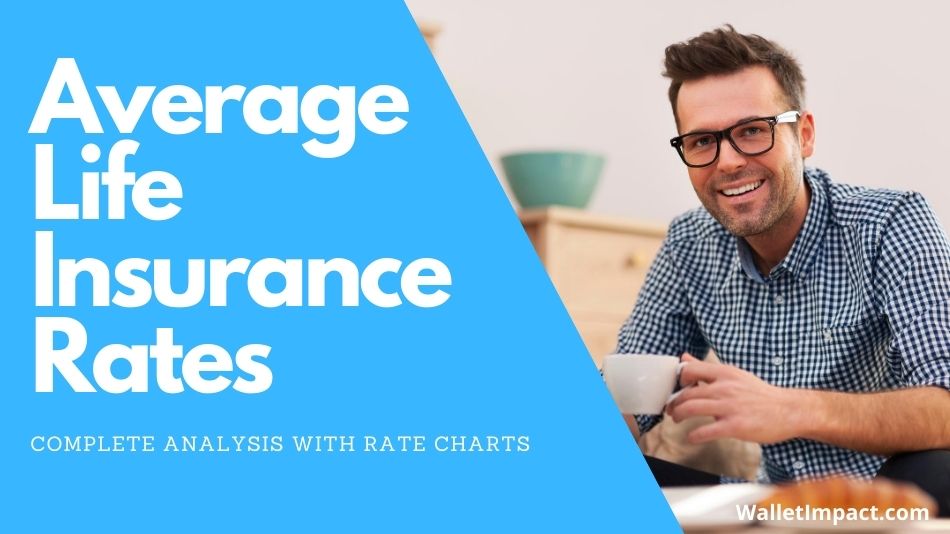What is the Average Life Insurance Cost Per Month [Includes Rate Charts]
As someone who has life insurance and at one time used to sell life insurance, you might be wondering what the average cost of life insurance is for you.
A $100,000 term life insurance death benefit for men can run between $12.64 at age 20 to $92.38 at age 60. A $100,000 term life insurance death benefit for women can run between $10.44 at age 20 to $54.87 at age 60. Life insurance costs very much for many reasons, from age, current health condition, the type of policy you decide to get, to the amount of coverage you get.
As you can see, the rates vary a lot, and to find the true cost, you need to consider several of these considerations. However, to give you an idea of what you might pay, I ran a few quotes with an insurance broker to help you see what’s possible.
Keep reading to see how much a life insurance policy could cost you.
Table of Contents
What is the Average Life Insurance Cost Per Month?

If you’re looking to buy life insurance, you may wonder how much this will cost you. In this article, I will share with you the actual rates I got from insurance companies.
This includes companies like Pacific Life, American General, Transamerica, Banner Life, Lincoln Financial Group, Prudential, and more.
Before I share the rates, I want to cover a few things.
First, rates can vary for a bunch of different reasons. The rates I’m sharing here will be for term life insurance with a death benefit of $100,000.
These rates are also based on a healthy person who does not smoke or has any health condition.
There are two charts. One for men and one for women. I did this to show you how rates between men and women vary.
Finally, none of these rates guarantee that you can or will get the rates I share below. After all, this is designed to show you what you could pay to get a quote.
All rates vary on various things, which I also cover further in this article.
Men’s Term Life Insurance Premiums Chart
| Age | Policy Type | Premiums/Monthly | Death Benefit |
| 20 | 30 Year Term | $12.64 – $18.77 | $100,000 |
| 30 | 30 Year Term | $12.98 – $19.72 | $100,000 |
| 40 | 30 Year Term | $18.12 – $28.83 | $100,000 |
| 50 | 30 Year Term | $38.50 – $61.70 | $100,000 |
| 60 | 20 Year Term | $54.65 – $92.38 | $100,000 |
| 70 | 20 Year Term | $206.23 – $397.06 | $100,000 |
| 80 | 10 Year Term | $289.63 – $753.02 | $100,000 |
*Rates are subject to change, as this is only an example.
Women’s Term Life Insurance Premiums Chart
| Age | Policy Type | Premiums/Monthly | Death Benefit |
| 20 | 30 Year Term | $10.44 – $13.51 | $100,000 |
| 30 | 30 Year Term | $10.75 – $14.15 | $100,000 |
| 40 | 30 Year Term | $15.11 – $19.60 | $100,000 |
| 50 | 30 Year Term | $27.57 – $38.42 | $100,000 |
| 60 | 20 Year Term | $36.37 – $54.87 | $100,000 |
| 70 | 20 Year Term | $171.48 – $323.79 | $100,000 |
| 80 | 10 Year Term | $198.11 – $496.77 | $100,000 |
*Rates are subject to change, as this is only an example.
Obviously, this is just the tip of the iceberg. These rates can go up or down for many different reasons, which I will cover more in the next section.
However, there are a few things I want to point out from the rates I ran above that I noticed.
#1 Rates Generally Stay Lower From Age 20 to Age 40. A healthy man or woman buying life insurance between the ages of 20 to 40 can expect to see lower rates. This is because younger people statistically have less of a chance of dying.
According to finder.com, at age 20, you only have 5.96% of dying within 30 years. At age 40, that jumps to a 23.41% chance of dying over the next 30 years.
#2 Rates After 50 Go Up Substantially. Obviously, the older you get, the higher your chances are that you’ll develop health issues, or even die as a result, and rates will go up. This means the earlier you buy your coverage, the better deal you will get. This is because once you buy your policy, the monthly rate or amount you pay will stay the same.
This includes all types of policies from term, universal, and whole life, to variable universal life insurance. The only way rates will change is if the policy lapses, starts a new one or adds something to your policy like a rider.
#3 Policy Types Change as You Get Older. Another thing you may notice is that the type of policy you can get differs as you get older. This is because insurance companies don’t like handing out a 30-year term policy to an 80-year-old person.
The chances of that person making it to the age of 110 are very unlikely. But there is a good chance an 80-year-old person may be able to live to be 90. This is why the term limits went down as they got older.
#4 Women Pay Less than Men. Finally, I’ve noticed from just a few quotes I’ve pulled that rates for women tend to be lower than for men.
This gets more noticeable the older you get. At a young age, the cost is only a few dollars different. However, the difference is huge at an older age, say 80.
In the example above, an 80-year-old man in good health can get a 10-year term policy for roughly $289.63, while an 80-year-old healthy woman could get the same policy for $198.11.
This difference is $91.52 a month or $1098.24 a year more!
These Aren’t the Only Differences
Now this isn’t the only place you’ll see a difference in rates. As I mentioned at the beginning of this article, there are many ways the rate of a life insurance policy can differ, and that is what I want to share with you in the rest of this article.
What Determines How Much Life Insurance Will Cost
There are actually 10 major things that can affect life insurance rates. In each way, I will give you examples of these costs.
#1 Age
The first factor that’s obviously going to play a big role in the rates you get on your life insurance policy is your age. As I pointed out earlier, the older you get, the more you will pay for life insurance.
However, let’s run a few numbers to give you an idea of how much. Based on the quote above, here are some rough numbers you could see when you quote a life insurance plan for yourself.
Men Term Life Insurance Rates
| Age | Policy Type | Premiums/Monthly | Death Benefit |
| 20 | 30 Year Term | $12.64 | $100,000 |
| 80 | 10 Year Term | $289.63 | $100,000 |
*Rates are subject to change, as this is only an example.
As you can see, rates grew by nearly $276.99 over 60 years. This means every year you wait to buy life insurance, it will cost you an average additional $4.62 per month or $55.44 per year more.
Now let’s see how much more it might cost for a woman if they decides to wait to buy life insurance.
| Age | Policy Type | Premiums/Monthly | Death Benefit |
| 20 | 30 Year Term | $10.44 | $100,000 |
| 80 | 10 Year Term | $198.11 | $100,000 |
*Rates are subject to change, as this is only an example.
For women, rates grew by $187.67 over 60 years. This means every year, you wait to buy life insurance. It will cost you, on average, an additional $3.13 per month or $37.56 per year more.
#2 Gender
As I covered earlier, gender also plays a big role in cost. To give you an idea of the cost difference, I put together this side-by-side comparison to show you the difference.
| Age | Men’s Premiums/Monthly | Women’s Premiums/Monthly | Difference |
| 20 | $12.64 | $10.44 | $2.20 |
| 30 | $12.98 | $10.75 | $2.23 |
| 40 | $18.12 | $15.11 | $3.01 |
| 50 | $38.58 | $27.57 | $11.01 |
| 60 | $54.65 | $36.37 | $18.28 |
| 70 | $206.23 | $171.48 | $34.75 |
| 80 | $289.63 | $198.11 | $91.52 |
*Rates are subject to change, as this is only an example.
Mortality charts show that men are more likely to die earlier than women, which is why the rates for men are so much higher at older ages.
#3 Your Current Health
Your current health also influences how much you’ll pay for your life insurance. If you have diabetes, heart problems, or even high cholesterol, it can raise your rates.
It can even determine if you’ll get life insurance in the first place. I’ve had clients who seemed perfectly fine and, after an extensive underwriting process, found the insurance company declined their coverage.
So what should you do if you’re in this situation? If you are still recovering from your situation, you may want to wait to purchase coverage until you’re in a healthier state.
At the very worst, you can apply for coverage to see if you can get it. The worst thing that can happen is that you’ll be declined.
#4 Smoking
Smoking also significantly affects how much you’ll pay for coverage.
| Age | Term | NonSmoking Male | Smoking Male | Difference |
| 20 | 30 Years | $12.64 | $33.32 | $20.68 |
| 30 | 30 Years | $12.98 | $38.33 | $25.35 |
| 40 | 30 Years | $18.12 | $69.02 | $50.90 |
| 50 | 30 Years | $38.50 | $152.25 | $113.75 |
| 60 | 20 Years | $54.65 | $234.05 | $179.40 |
| 70 | 15 Years | $206.23 | $445.46 | $239.23 |
| 80 | 10 Years | $289.63 | N/A | – |
If you can’t figure it out after reading the chart above, smoking will cost you big time. If you take out a term life policy at age 20 as a smoker, you’ll pay $20.68 more monthly.
If you pay that over a 30-year policy, you’ll pay around $7,444.80, not to mention all of those cigarettes literally burning a hole in your pocket.
That’s just at the age of 20. By age 50, it jumps to almost $114 a month extra, and it only goes up from there. After 30 years, you’ll have paid an extra $40,950. Ouch!
The bottom line is doesn’t pay to smoke. It’ll save you thousands of dollars in the long run.
#5 High-Risk Occupations

High-risk occupations may also drive up the cost of your life insurance. In fact, if you do certain activities, you may have to waive your right to be covered while doing it.
If you fly airplanes, skydives, rock climb, or a myriad of other things, you’ll likely have to sign a waiver allowing you to claim any of the death benefits if you do these activities.
So if you do any of these activities, you must disclose them when applying for coverage.
#6 Type of Life Insurance
The type of life insurance you get can also affect how much you’ll pay. If you have a term life policy, you’ll pay a different premium than if you get a universal life policy.
Below are some example rates I pulled for a $100,000 death benefit between a term life policy and a universal life policy.
| Age | Term Life | Universal Life | Coverage | Difference |
| 20 | $12.64 | $38.11 | $100,000 | $25.47 |
| 30 | $12.98 | $55.13 | $100,000 | $42.15 |
| 40 | $18.12 | $84.57 | $100,000 | $66.42 |
| 50 | $38.50 | $122.40 | $100,000 | $83.90 |
| 60 | $54.65 | $186.70 | $100,000 | $132.05 |
| 70 | $206.23 | $335.70 | $100,000 | $129.47 |
| 80 | $289.63 | $788.30 | $100,000 | $498.67 |
As you can see, going with a permanent type policy such as a whole life or universal life policy will be way more costly in the long term.
A term policy will be your cheapest option. At age 20, a universal life policy will cost 3 times more than a term life policy. Instead, why not just get 3 times the coverage for the same amount of money?
I did this several years ago when I got rid of my variable universal life policy, which had $250,000 of coverage, and switched to a term life policy and doubled my coverage for the same money.
#7 Amount of Life Insurance
The amount of life insurance you get can also play a big role in your pay.
You might think $100,000 in coverage would be enough, but what about your mortgage, car loans, kids’ college funds, and funeral expenses?
Here are a few quotes I ran on how prices can range for a 40-year-old male.
| Coverage | Policy | Monthly Premium |
| $100,000 | 30 Year Term | $30.63 |
| $200,000 | 30 Year Term | $46.73 |
| $300,000 | 30 Year Term | $66.87 |
| $400,000 | 30 Year Term | $87.00 |
| $500,000 | 30 Year Term | $104.52 |
One of the great things I’ve found with term life insurance is that the first $100,000 of a policy will cost the most. In this example of some rate I ran, I found that for a 40-year-old male, it would cost $30.63.
You would think for an additional $30, you would get only $200,000 in coverage, but you’ll actually get $300,000 in coverage.
Important: If you have to get more coverage, add it to your existing policy as that will likely be much cheaper than getting a new policy.
Also, think about the amount of coverage you’ll actually need. According to ThinkAdvisor, 40% of Americans are underinsured. Adding more coverage probably won’t cost as much as you think.
#8 Insurance Riders
Insurance riders can also add cost to your life insurance policy. One of the most common riders is the return on the premium rider. This rider does basically as it says, it returns the premiums you’ve paid over the policy’s life.
When I switched to term policy several years ago, I added this rider to my policy. What I like about this option is that I can elect to get all of my money back after my policy ends.
I also have the option to convert it to a paid-up policy as well if I choose to.
The question is, how much does it cost? Basis points charge riders. A basis point is a percentage of 1%. So if a rider costs 25 basis points, the cost of the rider will be a quarter of a percent.
For example, if your policy costs $30 and the cost of the rider is 25 basis points, then the rider might cost 7.5 cents a month.
The rider’s price varies by company, but you must talk to your insurance agent to determine its cost.
#9 Where You Live
Where you live can also raise or lower your premiums. However, this obviously will depend on the company goes with as well.
Insurance companies are regulated by the state where they reside, not the federal government. As a result, rates may vary in price.
However, a movement exists to change this and have the federal government oversee the insurance industry. This has happened for years, but I don’t expect that to change anytime soon.
#10 Weight
Finally, your height and weight can make a difference in your pay. A 200-pound male will pay vastly different rates than a 350-pound male.
Below is a chart to give an example of a $100,000 term life policy.
| Age | 200 lb Male | 350 lb Male | Difference |
| 20 | $12.64 | $19.47 | $6.83 |
| 30 | $12.98 | $19.75 | $6.77 |
| 40 | $18.12 | $32.63 | $14.51 |
| 50 | $38.50 | $72.61 | $34.11 |
| 60 | $54.65 | N/A | – |
| 70 | $206.23 | N/A | – |
| 80 | $289.63 | N/A | – |
Like all other things being overweight is going to cost you. What’s worse is that if you decide to buy life insurance late in life, there is a pretty good chance you won’t get coverage.
If you plan to buy coverage in your early 60’s and are overweight, you may not qualify for coverage.
Ultimately, being young and healthy will give you the best rates. So consider getting life insurance sooner rather than later.
What is the Average Life Insurance Cost Per Month – Final Thoughts
So what is the average life insurance cost per month? Overall there are many factors to play into the cost of life insurance. You may not be able to do anything about your health, where you live.
However, one thing you can do is buy it sooner rather than later. This will ultimately give you the best premiums and pay the least per thousand.
Once you’re in your golden years of life, it could cost you a lot. So get started now, and you’ll be covered for life. (No Pun Intended)






